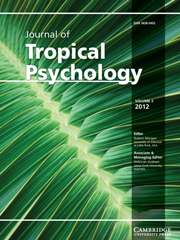Crossref Citations
This article has been cited by the following publications. This list is generated based on data provided by
Crossref.
Černovas, Andrejus
Alekna, Vidmantas
Tamulaitienė, Marija
and
Stukas, Rimantas
2018.
Reliability and Validity of the Lithuanian Version of CASP-19: A Quality of Life Questionnaire for the Elderly.
Medicina,
Vol. 54,
Issue. 6,
p.
103.
Abdul Mutalip, Mohd Hatta
Abdul Rahim, Faizul Akmal
Mohamed Haris, Hasmah
Yoep, Norzawati
Mahmud, Amierul Fikri
Salleh, Ruhaya
Lodz, Noor Aliza
Sooryanarayana, Rajini
Maw Pin, Tan
and
Ahmad, Noor Ani
2020.
Quality of life and its associated factors among older persons in Malaysia.
Geriatrics & Gerontology International,
Vol. 20,
Issue. S2,
p.
92.
Ahmad, Noor Ani
Abd Razak, Mohamad Aznuddin
Kassim, Mohd ShaifulAzlan
Sahril, Norhafizah
Ahmad, Fazila Haryati
Harith, Abdul Aziz
Mahmud, Nur Azna
Abdul Aziz, Fazly Azry
Hasim, Mohd Hazrin
Ismail, Hasimah
and
Mohd Sidik, Sherina
2020.
Association between functional limitations and depression among community‐dwelling older adults in Malaysia.
Geriatrics & Gerontology International,
Vol. 20,
Issue. S2,
p.
21.
Taufik Ramli, Muhd H
Lodz, Noor Aliza
Abdul Aziz, Fazly Azry
Maw Pin, Tan
Alias, Nazirah
Abdul Mutalip, Mohd Hatta
Sahril, Norhafizah
Kassim, Mohd Shaiful Azlan
Mat Rifin, Halizah
and
Muhammad, Eida Nurhadzira
2020.
Relationship between urinary incontinence and quality of life of older persons in Malaysia.
Geriatrics & Gerontology International,
Vol. 20,
Issue. S2,
p.
38.
Lane, Anna P.
Wong, Chek Hooi
Močnik, Špela
Song, Siqi
and
Yuen, Belinda
2020.
Association of Neighborhood Social Capital With Quality of Life Among Older People in Singapore.
Journal of Aging and Health,
Vol. 32,
Issue. 7-8,
p.
841.
Jaafar, Mohamad Hasif
Villiers-Tuthill, Amanda
Sim, Su Hua
Lim, Min Ai
and
Morgan, Karen
2020.
Validation of the Brief Ageing Perceptions Questionnaire (B-APQ) in Malaysia.
Aging & Mental Health,
Vol. 24,
Issue. 4,
p.
620.
Lai, Siow Li
and
Tey, Nai Peng
2021.
The Quality of Life of Older Adults in a Multiethnic Metropolitan: An Analysis of CASP-19.
SAGE Open,
Vol. 11,
Issue. 2,
p.
215824402110299.
Ong, Janice Ying Qian
Mat, Sumaiyah
Kioh, Sheng Hui
Hasmuk, Kejal
Saedon, Nor’izzati
Mahadzir, Hazlina
Chin, Ai-Vyrn
Kamaruzzaman, Shahrul Bahyah
and
Tan, Maw Pin
2022.
Cognitive frailty and 5-year adverse health-related outcomes for the Malaysian elders longitudinal research (MELoR) study.
European Geriatric Medicine,
Vol. 13,
Issue. 6,
p.
1309.
Mat, Sumaiyah
Ng, Chin Teck
Fadzli, Farhana
Rozalli, Faizatul Izza
Morgan, Karen
and
Tan, Maw Pin
2022.
Factors Influencing Quality of Life Among Older Persons Living With Osteoarthritis Using 3 Different Definitions.
Topics in Geriatric Rehabilitation,
Vol. 38,
Issue. 1,
p.
26.
Tan, Li Ting
Østbye, Truls
Visaria, Abhijit
and
Malhotra, Rahul
2023.
Derivation, and establishment of the validity and reliability, of the CASP-11-SG quality of life scale among community-dwelling older adults.
Quality of Life Research,
Vol. 32,
Issue. 1,
p.
295.




